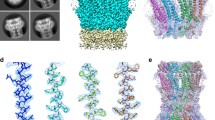Abstract
Subcellular fractions enriched in gap junctions with an ultrastructure similar to those in intact insect tissue have been obtained by extracting crude membranes from the tobacco budworm Heliothis virescens (Lepidoptera: Noctuidae) with 2.5 mM NaOH. n-Octyl-β-d-glucopyranoside (OG) was used to further purify integral membrane proteins in the NaOH-extracted fractions. A polyclonal antibody (R16) is described that specifically labels nonextracted and NaOH-extracted gap junctions in cell fractions by electron microscope immunocytochemistry. R16 immunostaining of sectioned Heliothis testis at the light-microscope level yields a pattern of immunoreactivity consistent with the distribution of gap junctions in the tissue. R16 identifies a 40-kDa protein as a candidate gap junction protein on immunoblots of crude membrane, NaOH-extracted and NaOH/OG-extracted fractions.
Similar content being viewed by others
References
Berdan RC (1987) Intercellular communication in arthropods, biophysical, ultrastructural and biochemical approaches. In: DcMello W (ed) Cell-to-cell communication, Plenum Press, New York, pp 299–370
Berdan RC, Gilula NB (1988) The arthropod gap junction and pscudo-gap junction: isolation and preliminary biochemical analysis. Cell Tissue Res 251:257–274
Beyer EC, Paul DL, Goodenough DA (1987) Connexin43: a protein from rat heart homologous to a gap junction protein from liver. J Cell Biol 105:2621–2629
Caveney S (1985) The role of gap junctions in development. Annu Rev Physiol 47:319–335
Dermietzel R, Hwang TK, Spray DC (1990) The gap junction family: structure, function and chemistry. Anat Embryol 182:517–528
Egbali B, Kessler JA, Spray DC (1990) Expression of gap junction channels in communication-incompetent cells after stable transfection with cDNA encoding connexin32. Proc Natl Acad Sci USA 87:1328–1331
Epstein ML, Gilula NB (1977) A study of communication specificity between cells in culture. J Cell Biol 75:769–787
Finbow ME, Eldridge T, Buultjens J, Lane NJ, Shuttleworth, J, Pitts JD (1984) Isolation and characterization of arthropod gap junctions. EMBO J 3:2271–2278
Gould RJ, Ginsberg BH, Spector AA (1981) Effects of octyl β-glucoside on insulin binding to solubilized membrane receptors. Biochemistry 20:6776–6781
Green CR, Noirot-Timothee C, Noirot C (1983) Isolation and characterization of invertebrate smooth spetate junctions. J Cell Sci 62:351–370
Guthrie SC, Gilula NB (1989) Gap junctional communication and development. Trends Neurosci 12:12–16
Haefliger JA, Bruzzone R, Jenkins NA, Gilbert DJ, Copeland NG, Paul DL (1992) Four novel members of the connexin family of gap junction proteins. J Biol Chem 267:2057–2064
Hertzberg EL (1984) A detergent-independent procedure for the isolation of gap junctions from rat liver. J Biol Chem 259:9936–9943
Lane NJ, Skaer H le B (1980) Intercellular junctions in insect tissues. Adv Insect Physiol 15:35–213
Leitch B, Finbow ME (1990) The gap junction-like form of a vacuolar proton channel component appears not to be an artifact of isolation: an immunocytochemical localization study. Exp Cell Res 190:218–226
Liebrich W, Schroeder D (1982) Gap junctions in spermatocyte cysts of Drosophila hydei testis. Int J Invert Reprod 5:243–245
Lowenstein WR (1979) Junctional intercellular communication and the control of growth. Biochim Biophys Acta 560:1–65
MacDonald C (1985) Gap junctions and cell-cell communication. Essays Biochem 21:86–118
Matsudaira P (1987) Sequence from picomole quantities of proteins electroblotted onto polyvinylidene difluoride membranes. J Biol Chem 262:10035–10038
Paul DL, Goodenough DA (1983) Preparation, characterization, and localization of antisera against bovine MP26, an integral protein from lens fiber plasma membrane. J Cell Biol 96:625–632
Revel JP (1988) The oldest multicellular animal and its junctions. In: Hertzberg EL, Johnson RG (eds) Gap junctions. (Modern cell biology, vol 7) Liss, New York, pp 135–149
Rosevear P, VanAken T, Baxter J, Ferguson-Miller S (1980) Alkyl glycoside detergents: a simple synthesis and their effects on kinetic and physical properties of cytochrome c oxidase. Biochemistry 19:4108–4115
Ryerse JS (1989a) Isolation and characterization of gap junctions from Drosophila melanogaster. Cell Tissue Res 256:7–16
Ryerse JS (1989b) Electron microscope immunolocation of gap junctions in Drosophila. Tissue Cell 21:835–839
Ryerse JS (1991) Gap junction-associated protein tissue distribution and abundance in the adult brain of Drosophila. Tissue Cell 23:709–718
Stauffer KA, Kumar NM, Gilula NB, Unwin N (1991) Isolation and purification of gap junction channels J Cell Biol 115:141–150
Swenson KI, Jordan JR, Beyer EC, Paul DL (1989) Formation of gap junctions by expression of connexins in Xenopus oocyte pairs. Cell 57:145–155
Szollosi A, Marcaillou C (1980) Gap junctions between germ and somatic cells in the testis of the moth, Anagasta kuehniella (Insecta: Lepidoptera). Cell Tissue Res 213:137–147
Author information
Authors and Affiliations
Rights and permissions
About this article
Cite this article
Ryerse, J.S. Structural, immunocytochemical and initial biochemical characterization of NAOH-extracted gap junctions from an insect, Heliothis virescens . Cell Tissue Res 274, 393–403 (1993). https://doi.org/10.1007/BF00318758
Received:
Accepted:
Issue Date:
DOI: https://doi.org/10.1007/BF00318758




